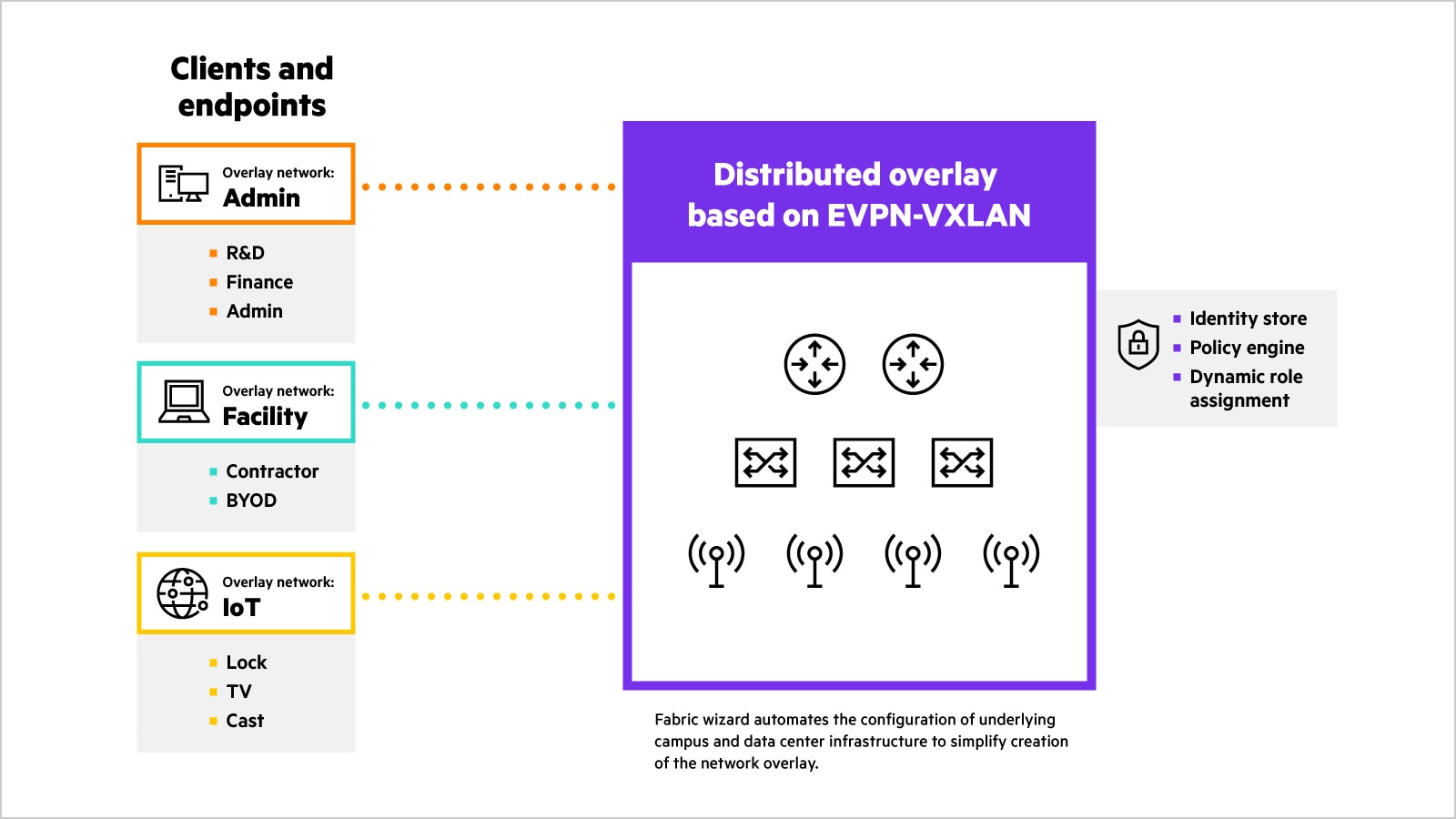
Network Overlay What is a Network Overlay?
A network overlay is a logical construct that “stitches” together disparate, dispersed network infrastructure (often referred to as underlay). Network overlays (“fabrics”) are an ideal choice for managing and securing complex, highly distributed networks.

- Network overlays explained
- Why consider a network overlay?
- How a network overlay works
- Options for a network overlay
- Example of distributed overlay fabric using EVPN-VXLAN
- What are the benefits of a network overlay?
- Questions to ask when selecting a network overlay solution
Network overlays explained
An overlay is a method of defining layers of network abstraction using software to run multiple separate, virtualized networks on top of a physical layer. Network overlays provide the ability to deploy flexible services based on ever-changing connectivity and mobility demands of the endpoints and applications.
Why consider a network overlay?
Digital acceleration driven by hybrid work, new customer and user experiences, and the need for improved IT efficiencies makes it more important than ever for the network to provide necessary flexibility and security to keep up with constantly changing business requirements. Advancing critical business initiatives while managing a growing volume of network sites and topologies can quickly become overwhelming. By using a network overlay, network and security administrators can configure disparate and dispersed infrastructure using a common set of services—no hands-on configuring of the underlying infrastructure required.
How a network overlay works
Widely adopted protocols, such as EVPN-VXLAN, use encapsulation to produce an intelligent network overlay suitable for rapid enterprise network deployment and massive scalability.
Decoupling the overlay network from the physical topology enables on-demand deployment of layer 2 and layer 3 services, irrespective of the underlay physical topology. This eliminates the cost of manually modifying the network to cater to the movement of clients and applications.
Network overlays also carry endpoint or user role information across the network without requiring all devices in the path to understand or manage the roles.
Options for a network overlay
You can use different kinds of network overlays and routing/bridging protocols. One example is EVPN-VXLAN-GBP with BGP, which is used to enforce user segmentation from switch to switch.
Other kinds of network overlays and protocols include:
- L2-GRE with OTO (AP to gateway)
- L2-GRE with PAPI (switch to gateway)
- ORO-VXLAN-GBP with OTO (gateway to gateway)
- L2-VXLAN-GBP with STP (gateway to switch)
Example of distributed overlay fabric using EVPN-VXLAN
HPE Aruba Networking Central NetConductor | Full stack solution for cloud-native network & security orchestration.


What are the benefits of a network overlay?
Network overlays provide:
- Scalability—A network overlay can provide greater scalability than traditional VLAN-based approaches that require extensive manual monitoring and configuration.
- Simplicity—Holistic control of the enterprise network, facilitated by the network overlay, eliminates the need for labor-intensive management of physical and virtual infrastructure.
- Speed—Using a network overlay to deploy and operate a geographically dispersed network is much faster than using manual methods, such as VLANs.
Questions to ask when selecting a network overlay solution
Creating and managing a network overlay can be complex, so many organizations rely on network overlay solutions. However, not all solutions are created equal. Consider the following when evaluating network overlay solutions.
- Does the solution offer a single pane of management for all networks in your environment—campus, data center, and SD-WAN? Using multiple tools to manage different parts of the network can mitigate many of the simplicity benefits of using a network overlay.
- Does the solution require a rip and replace of network infrastructure? Organizations often have legacy infrastructure in place. A network overlay solution that allows for flexibility in evolution provides benefits now that can be expanded later as infrastructure needs evolve.
- Does the network overlay solution offer flexibility in network architecture design? There are many different frameworks and protocols available for network overlays; preserving flexibility to choose can improve the organization’s ability to adapt for future requirements.
